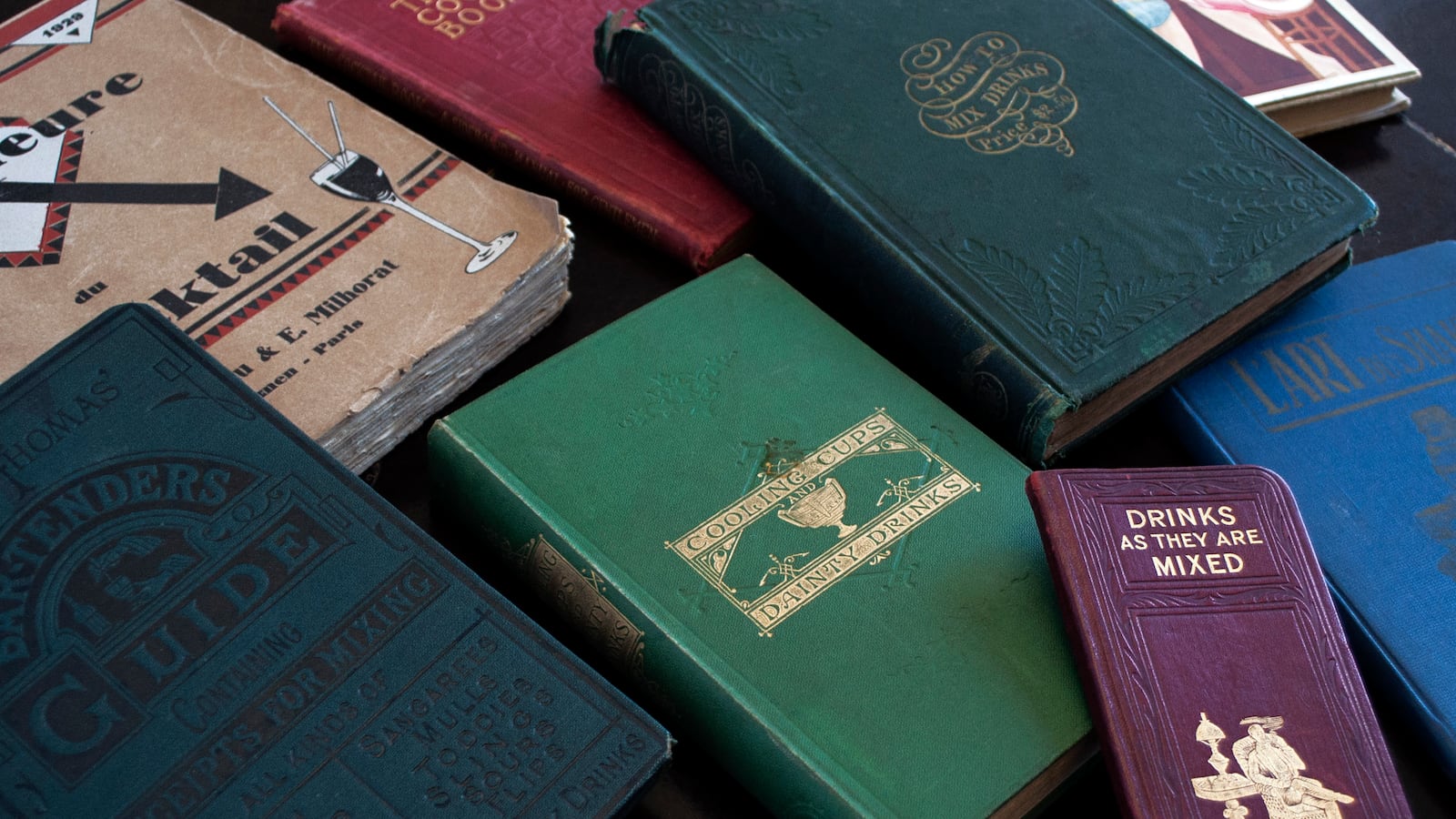Up until about two decades ago, vintage cocktail books were like lint—they turned up in the cracks between “serious” books in the cooking sections at used book stores, and could be found for a quarter in battered cardboard boxes at garage sales.
Then along came eBay and Alibris and other shortcuts to assessing value and selling online. And along came the cocktail renaissance, in which the wisdom of the elders transcended to cult status, and bound volumes containing the same commanded top dollar. A first edition of The Fine Art of Mixing Drinks, published in 1948, is listed today on Alibris for $6,500 (the priciest of any cocktail book currently listed). Signed editions of The Savoy Cocktail Book, first published in 1930 are on offer for between $1,000 and $1,600.
While many rare volumes have become difficult to acquire thanks to scarcity and soaring prices, many are actually easier to read thanks to reprints and technology. Cocktail Kingdom has put out a series of fine reprints. Google Books has become a mandatory first stop in cocktail research. And earlier this year another remarkable database of vintage cocktail books, the culmination of a three-year project, was formally launched. Created by Anastasia Miller and Jared Brown in conjunction with the Exposition Universelle des Vins et Spiritueux, a museum in southern France, it contains more than 1,000 rare and valuable drinks-focused books that may be perused online page by page for free.
Yet some books about drink remain elusive, known but never seen, empty chalices waiting to be filled and drunk.
Perhaps the holiest of grails is the much-speculated-upon-but-never-actually-found first cocktail manual written by Harry Johnson. A Prussian emigre who started mixing drinks at age 15 in late Gold-Rush-era San Francisco, Johnson would go on to become the consummate bartender and manager, writing a guide that not only spelled out recipes, but also elucidated the means of becoming a proper bartender. “The drinks I invented and the way I mixed them attracted many patrons to the bar,” he once wrote, with limited modesty. “I had so many requests from other bartenders to how I made this or that drink that I wrote a little book which I called the ‘Bartenders’ Manual’.”
While many are familiar with Harry Johnson’s New and Improved Bartender’s Manual, or How to Mix Drinks in the Present Style, published in 1882, Johnson also claimed to have written and published an earlier edition, in 1860. What makes that notable is, if true, it would have predated Jerry Thomas’s landmark 1862 cocktail book (The Bar-Tender’s Guide, A Complete Cyclopaedia of Plain and Fancy Drinks), which has long been considered the first cocktail guide ever published. (Thomas’s second book is also one that nobody has ever seen a copy of.)
“There was published by me, in San Francisco, the first Bartender’s Manual ever issued in the United States,” Johnson wrote. “This publication was a virtual necessity-the result of a constant demand for such a treatise by those everywhere engaged in the hotel, bar and restaurant business.”
Johnson went on to claim that this edition sold 10,000 copies of that first release in less than a week—an impressive number in any era. Yet curiously, not a single copy has ever been found. It might be, as one online commenter recently speculated, that “only the San Francisco fire’s destruction can explain why no book ever turned up.”
Another explanation for the book’s disappearance is simpler, proposed by my fellow Daily Beast columnist David Wondrich in his book, Imbibe: “there are grounds for taking the things that came out of his mouth with a grain of salt.” In other words, that 1860 edition may have existed only in Johnson’s boastful imagination.
Even Johnson’s 1882 edition is exceedingly hard to find in print. “No one has a copy that I know of,” says Dale DeGroff, a pioneer in the cocktail renaissance and author of The Craft of the Cocktail. Another fabled but unseen cocktail book, DeGroff says, is the 1884 Modern Bartender’s Guide, written by the pseudonymous O.H. Byron. “The beautiful dust jacket…is all that remains.,” DeGroff says. “It was published on acid paper and as far as I know no copies have survived,” and may explain why it’s never benefited from a reprint.
DeGroff also mentioned a rarely seen collectible from 1936: “Hemingway’s bartender at the Ritz, Frank Meier, in Paris, did a series of private editions of The Artistry of Mixing Drinks,” he says. Twenty-six copies were specially printed for the author with over-the-top hand-crafted design elements, then another 300 on handmade paper, and finally another 700 on cream vellum paper. (DeGroff has one of latter.) It was reprinted in 2009 by Cocktail Kingdom.
Cocktail guide sleuth Martin Doudoroff has gathered dozens of early recipes culled from vintage guides on his app, “Martin’s New & Improved Index of Cocktails & Mixed Drinks.” “The biggest White Whale for me has been the hypothetical 1884 first edition of Theodore Proulx’s Bartender’s Manual,” Doudoroff says. “If it ever existed, and still exists, it might be revelatory. Or not.” (Some believe that the first published reference to the “old-fashioned cocktail” appeared in Proulx’s volume.)
Distillers often seek out antique distilling guides outlining lost techniques. Ted Breaux, an absinthe pioneer who did more than anyone else to reintroduced the now-legal spirit to the United States, says there’s actually little he hasn’t found. “The only distillation manuals I read are in French,” he says, and few have eluded him. “And I’ve not found much in English ... not of what I consider to be of professional quality anyway.”
Todd Leopold of Leopold Brothers Distillery in Denver, says that he’s also been able to find most of what he’s sought. Among the more influential finds for him was an obscure 1907 Internal Revenue Service study, which surveyed 31 distillers in quest of an answer to the question of how bourbon and rye should be defined. From that, Leopold not only found that most barreled at a far lower proof than today (around 100 proof vs. 125 proof), but he also found prominent references to three-chambered stills, a style of still design once commonly used to make rye, but then lost. “This paper not only solidified my resolve to get my hands on a three chamber still”—he had one custom made based on sketchy plans he found later—“but also my conviction that low entry proof not only makes better whiskey, but that an entry proof of 100 proof is the American tradition.”
As for other historic manuals and guides, Leopold admits that there are still the “unknown unknowns.” “I haven’t had the time to do exhaustive work at, say, the Library of Congress, to fish for manuals and books that I’ve never seen before,” he says.
While the majority of early cocktail books have been discovered and have either been reprinted or made available online, there’s another category of cocktail guide that remains evasive. Rare book dealers call it ephemera—often pamphlets or commercial circulars printed in bulk, distributed cheap or free, and then discarded.
St. John Frizell, owner of Fort Defiance bar in Brooklyn, spent weeks following in the footsteps of Charles Baker, author of the landmark 1939 book The Gentleman’s Companion: Being an Exotic Cookery and Drinking Book. (Later released as Around the World with Jigger, Beaker and Flask.)
“The only thing that Baker wrote that was very hard to track down was a pamphlet… for Panagra Airlines about where to eat and drink in South America—a kind of miniature (and precursor to) the [South America] Gentleman’s Companion,” Frizell said. “And I would love to see the magazine that he published in the 1920s, called Zest, but I’ve kind of given up on that.”
For Matt Pietrek, the blogger behind the website Cocktail Wonk, his version of unobtanium is José Arechabala, S. A., on Its 75th. Anniversary, 1878-1953, a privately printed commemorative edition outlining the history of one of Cuba’s most prominent rum distilleries. “It’s particularly interesting to me, as I’m trying to conclusively prove/disprove that there were column stills in Cuba prior to 1911,” he says. It’s not available online, but he thinks copies may exist in a library or two.
Matthew Rowley, a writer whose Lost Recipes of Prohibition: Notes from a Bootlegger’s Manual, is essentially a book-length study of a single handwritten notebook, suspects that at this point the gold mine of early cocktail books has been pretty well tapped, but that more treasure may be found if the cocktail curious look further afield. “It’s far too easy when researching historical drinks and cocktail recipes to stick to the books, articles, and studies that concern historical drinks and cocktail recipes,” he says. “But most of those books have been well-mined by competent researchers, drinkers, bartenders, bloggers, etc. I don’t think we’re likely to find any additional revolutionary insight in the kinds of drinks books we’ve been collecting and studying for the last 20 or 30 years.”
However, he adds, “it may be more useful for us to look at sources from other fields and written in other languages. There’s a whole, whole lot of information about drinks in cookbooks, for example. Yet they don’t get a lot of attention from many drinks researchers.” Those who do pay attention are often rewarded — Rowley cites bartender Chris Hannah of Arnaud’s French 75 in New Orleans, who turned up a key recipe for Parfait Amour in the Picayune’s Creole Cookbook, originally published in 1901.
The great white whales of the cocktail book may be growing vanishingly scarce. (Shake fist at sky while muttering, “Damn you, Harry Johnson.”) Yet it turns out there’s plenty more nutrition in the sea. It’s just that it’s now in the form of minnows and krill, and not in that 500-ton whale.
So a message to those still searching for ideas and inspiration from unmapped cocktail and spirits of times past: Keep casting your nets, but do so in sparser seas. Pull them in. See what you get. Report what you find.






